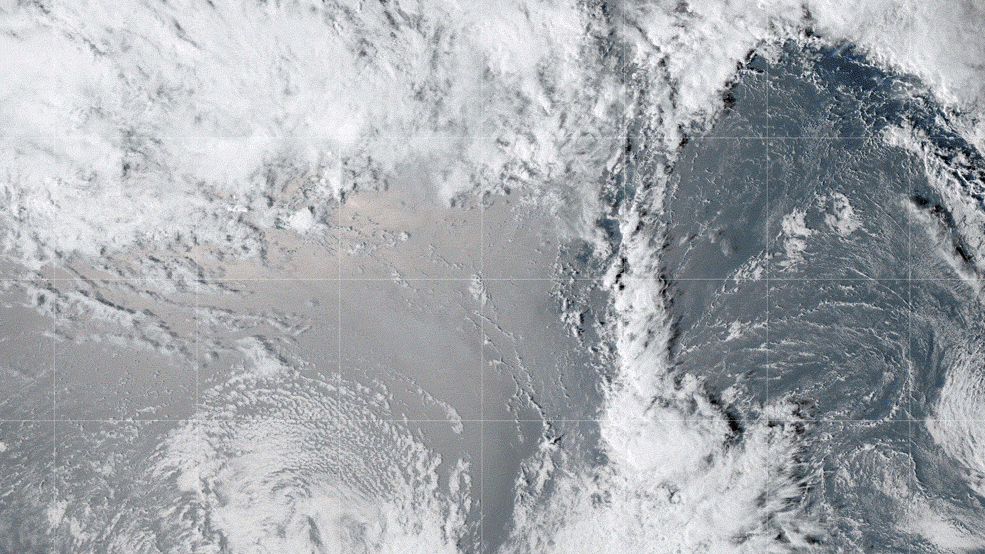Huge Tonga volcanic eruption spawned record-breaking winds at the edge of space
'This is something we’ve only previously seen with strong geomagnetic storms.'

The powerful Hunga Tonga-Hunga Ha‘apai volcanic eruption in January 2022 triggered stronger-than-hurricane winds in the highest layer of Earth's atmosphere, challenging scientists' understanding of the influence our planet has on outer space.
The eruption, which sent devastating tsunamis across the Pacific Ocean on Jan. 15, not only blasted hundreds of millions of tons of volcanic ash into the stratosphere but also generated shockwaves that reached as high as the planet's ionosphere, the outermost layer of the atmosphere at altitudes of up to 400 miles (650 kilometers).
These shockwaves were so powerful that they triggered winds with staggering speeds of up to 450 mph (720 kph) that were measurable by satellites at altitudes of up to 120 miles (190 km). That's way above the official edge of space, the so-called Karman line at the altitude of 62 miles (100 km). For comparison, the strongest hurricanes on Earth can reach a maximum wind speed of around 200 mph (320 kph).
"I don't think any of us expected to see anything this large," Brian Harding, a physicist at University of California, Berkeley, and lead author of a new study describing the observations, told Space.com. "We expected the disturbances to be small, like little ripples that went into the ionosphere."
Related: Explosive underwater volcano eruption in Tonga spotted from space in satellite images
Harding worked with data from a NASA mission called the Ionospheric Connection Explorer (ICON), which studies how space weather interacts with Earth's ionosphere. Previously, scientists mostly thought that the ionosphere is quite isolated from the planet and only affected by the activity of the sun. But the disturbances detected after the Hunga Tonga-Hunga Ha‘apai eruption were, in fact, the most significant ICON has measured in its more than two years in orbit. They were more powerful than any of those caused by the countless geomagnetic storms, which the planet has experienced in that period of time as a result of the sun's activity.
These powerful winds were associated with the so-called equatorial electrojet, an electric current that circles through the ionosphere above Earth's equator. Measurements by ICON, as well as those by Europe's three-satellite Swarm mission, revealed that this electrojet went haywire in the days after the Hunga Tonga eruption. It flipped direction several times and surged to five times its usual strength, according to a NASA statement.
Get the Space.com Newsletter
Breaking space news, the latest updates on rocket launches, skywatching events and more!
"The equatorial electrojet is a very strong electrical current of hundreds of kilowatts that exists in a narrow band near the equator," said Harding. "It's a result of some complicated physics that go on in Earth's magnetic field. It typically flows eastwards and sometimes can be reversed by geomagnetic storms. But this was the first time we have seen it completely reverse and strengthen because of something that happened on the ground."
Commenting on the results, Jim Spann, space weather lead at NASA’s Heliophysics Division at NASA headquarters in Washington, D.C., said in the statement: "These results are an exciting look at how events on Earth can affect weather in space, in addition to space weather affecting Earth."
The Hunga Tonga eruption was the most powerful volcanic explosion to have shaken Earth since that of Mount Pinatubo in the Philippines in 1991. The blast could be heard at a distance of over 6,000 miles (10,000 km), and the pressure wave it generated circled the planet four times. Fortunately, only three people died in the tsunami triggered by the eruption, despite the damage the waves caused in the Polynesian Kingdom of Tonga.
The study was published in the journal Geophysical Research Letters on May 10.
Follow Tereza Pultarova on Twitter @TerezaPultarova. Follow us on Twitter @Spacedotcom and on Facebook.
Join our Space Forums to keep talking space on the latest missions, night sky and more! And if you have a news tip, correction or comment, let us know at: community@space.com.

Tereza is a London-based science and technology journalist, aspiring fiction writer and amateur gymnast. Originally from Prague, the Czech Republic, she spent the first seven years of her career working as a reporter, script-writer and presenter for various TV programmes of the Czech Public Service Television. She later took a career break to pursue further education and added a Master's in Science from the International Space University, France, to her Bachelor's in Journalism and Master's in Cultural Anthropology from Prague's Charles University. She worked as a reporter at the Engineering and Technology magazine, freelanced for a range of publications including Live Science, Space.com, Professional Engineering, Via Satellite and Space News and served as a maternity cover science editor at the European Space Agency.









